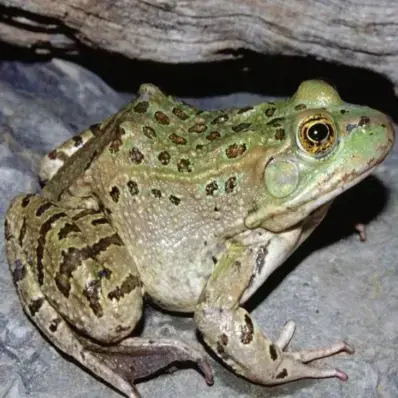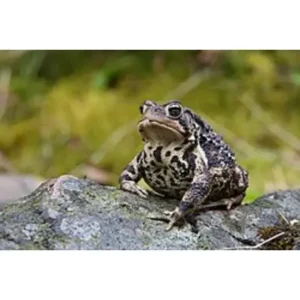History/Origin
The American Bullfrog has a long history in North America. These frogs have been around for several centuries, and they are originally from areas east of the Rocky Mountains. They have adapted to different environments and play a vital role in wetlands.
Their name originates in the distinctive and resonant calls made by male bullfrogs during the breeding season. They’ve been part of the North American landscape for a significant amount of time, showcasing their endurance and importance in the region’s ecosystems.
Personality
American Bullfrogs exhibit a primarily nocturnal behavior, being more active during the night. They are known for their distinct croaking calls, used to attract mates. Despite their seemingly solitary nature, they play a crucial role in maintaining ecological balance by controlling insect populations.
As pets, American Bullfrogs display curious behaviors and may recognize their owners during feeding times.
Physical Appearance
Let’s explore the fascinating appearance of the American Bullfrog:
- Size: American Bullfrogs have strong bodies, measuring between 3.6 to 6 inches (9 to 15 cm) in length.
- Coat Color: The American Bullfrog’s skin is usually green or brown with dark markings, providing effective camouflage that helps them blend into their surroundings.
- Skin Specialized Features: The skin of American Bullfrogs has a unique texture with small warts or granules, contributing to their appearance and potentially aiding in protection and camouflage. These features highlight the intricate design of the bullfrog, helping it navigate and thrive in various environments.
Gender Differences
Male and female American Bullfrogs exhibit distinct characteristics, with notable differences in size, anatomical features, and behavior.
- Size: One prominent difference lies in size, as male American Bullfrogs are generally smaller than their female counterparts.
- Eardrums and Eyes: An anatomical distinction is evident in the size of eardrums in comparison to their eyes. Male American Bullfrogs typically possess eardrums that are larger than their eyes, while females exhibit a more proportional size relationship between these features.
- Breeding Season: During the breeding season, males undergo a distinctive transformation as they develop a vibrant yellow throat. This visual cue serves as a key indicator of reproductive readiness and is a characteristic feature specific to male bullfrogs during this crucial period.
Feed/Nutrition
So what does the American Bullfrog eat? Well, Bullfrogs are opportunistic feeders with a diverse diet consisting of various prey items that contribute to their overall nutritional needs.
- Insects:
Insects, such as crickets, grasshoppers, and beetles, form a significant portion of the American bullfrog’s diet. Insects serve as a crucial protein source, supporting growth and maintaining muscle health.
- Small Fish
American Bullfrogs readily consume small fish, such as minnows and tadpoles. Fish contribute omega-3 fatty acids, promoting cardiovascular health and aiding in overall well-being.
- Small Mammals
Bullfrogs may opportunistically feed on small mammals like mice or shrews. Including mammals provides additional nutrients, enhancing the overall nutritional profile of their diet.
Feeding Practices
For optimal care of your American Bullfrog pet, maintain a varied diet with prey items like crickets, mealworms, and small fish. Adjust portion sizes based on the frog’s age and size.
Feed juvenile bullfrogs daily to support growth, reducing frequency to 2-3 times per week as they mature. Dust prey with calcium supplements and provide a reptile multivitamin.
Always offer clean, dechlorinated water, and monitor your frog’s health regularly. Incorporate environmental enrichment for natural hunting behaviors, ensuring a balanced and thriving pet.
Health
American Bullfrogs, while generally hardy, can face health issues that require careful attention. Understanding and addressing common concerns is crucial for their well-being.
Chytridiomycosis
Chytridiomycosis, caused by the chytrid fungus, is a prevalent health concern. This fungus can lead to skin infections, affecting the bullfrog’s ability to breathe through its skin.
For prevention, maintain a clean and well-sanitized environment to minimize the risk of fungal infections.
Parasitic Infections
Bullfrogs may be susceptible to internal parasites affecting organs and external parasites infesting their skin. Routine veterinary check-ups can help identify and treat parasitic infections promptly.
Adequate Water Quality
Ensure water quality meets appropriate parameters, including temperature and pH, to prevent stress and illness. Use efficient filtration systems to keep the aquatic habitat clean and free from harmful microorganisms.
Suitable Environment
Maintain suitable temperature and humidity levels within the enclosure to prevent stress-related health issues. Provide ample space and appropriate hiding spots to reduce stress and promote mental well-being.
Care and Grooming
The American Bullfrogs habitat plays a significant and impactful role in maintaining their well-being. Regularly monitor the water quality in their aquatic environment, maintaining cleanliness to prevent potential health issues.
Provide a spacious enclosure with suitable hiding spots, catering to their natural behaviors.
Additionally, regulate the temperature within the habitat to create an environment conducive to their needs. These attentive measures in care and grooming are fundamental to fostering a healthy and thriving life for American Bullfrogs in captivity.
Rescue Groups
Amphibian rescue groups play a vital role in safeguarding and rehabilitating American Bullfrogs. Notable organizations actively involved in amphibian rescue and conservation efforts include:
Species for Sale
Discover online platforms below where American Bullfrogs are available for purchase.
Interesting Facts
- American Bullfrogs can jump up to 10 times their body length in a single leap.
- These amphibians have a unique “gular fold,” a loose skin flap beneath their jaw, allowing their throats to expand during vocalizations.
- The American Bullfrog tadpoles are often cannibalistic, sometimes consuming smaller tadpoles.
- Bullfrogs have a third eyelid called a nictitating membrane, providing additional eye protection while underwater.
Best For
When provided with optimal conditions, American Bullfrogs can become wonderful pets, emphasizing their crucial role in environmental conservation within wetland habitats.
Top Names
| Male American Bullfrog Names | Female American Bullfrog Names |
| Nimbus | Seraphina |
| Zephyr | Azura |
| Quasar | Cascade |
| Orion | Prism |
| Dynamo | Celestia |










